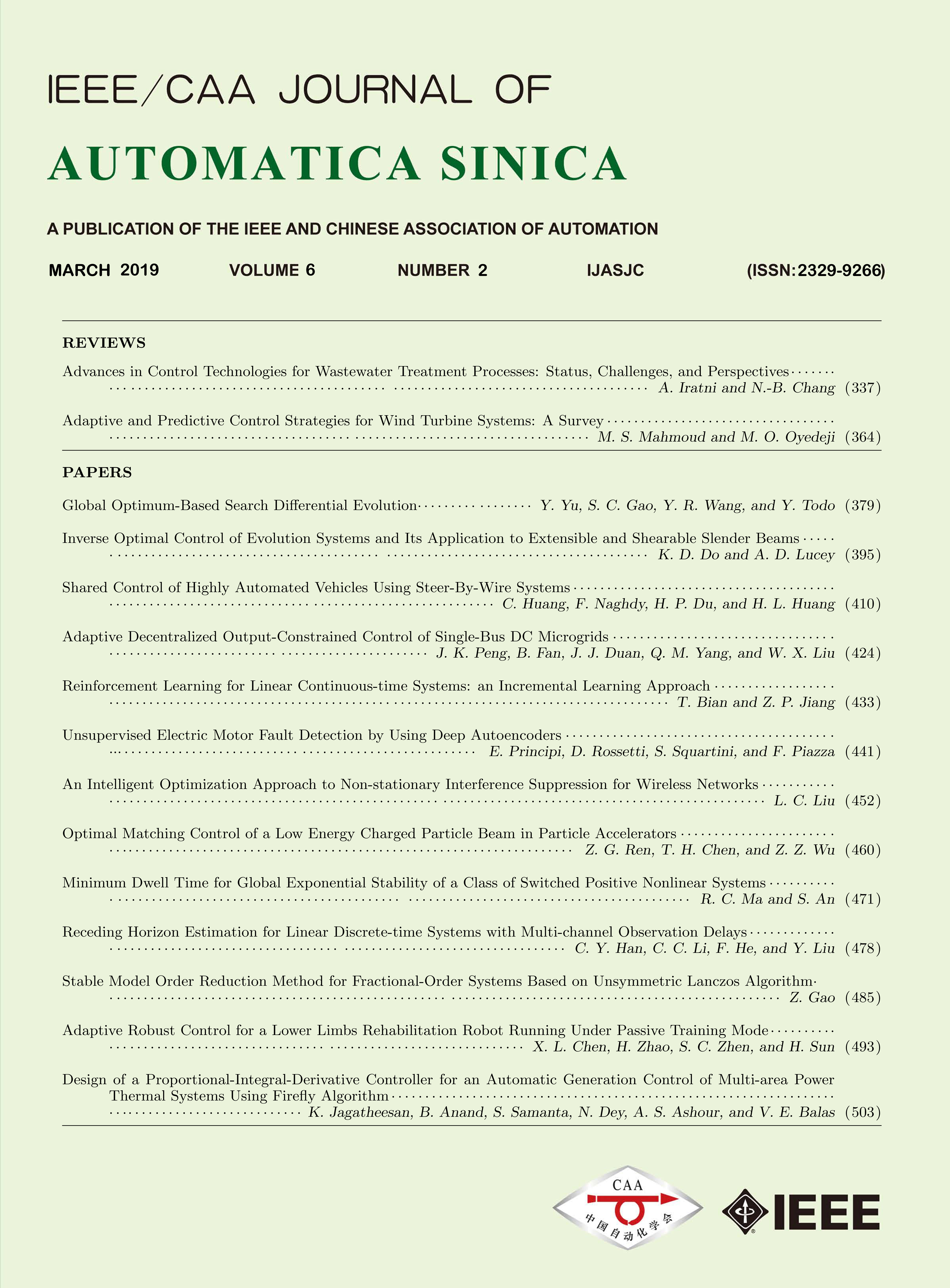 Volume 6
Issue 2
Volume 6
Issue 2
IEEE/CAA Journal of Automatica Sinica
| Citation: | Can Luo, Zhen Shen, Simos Evangelou, Gang Xiong and Fei-Yue Wang, "The Combination of Two Control Strategies for Series Hybrid Electric Vehicles," IEEE/CAA J. Autom. Sinica, vol. 6, no. 2, pp. 596-608, Mar. 2019. doi: 10.1109/JAS.2019.1911420 |

| [1] |
I. Resitoglu, K. Altinisik, and A. Keskin, "The pollutant emissions from diesel-engine vehicles and exhaust aftertreatment systems, " Clean Technologies & Environmental Policy, vol. 17, no. 1, pp. 15-27, 2015. doi: 10.1007/s10098-014-0793-9
|
| [2] |
"The Rise of Electric Vehicles in Japan, " Electric Vehicles, Technology Innovation, 2016.[Online]. Available: https://www.westernautomation.com/technology-innovations/the-rise-of-electric-vehicles-in-japan/.
|
| [3] |
"Electric vehicle outlook 2018, " Bloomberg, 2018.[Online]. Available: https://about.bnef.com/electric-vehicle-outlook/.
|
| [4] |
F.-Y. Wang, "Agent-based control for networked traffic management systems, " IEEE Intelligent Systerms, vol. 20, no. 5, pp. 92-96, 2005. doi: 10.1109/MIS.2005.80
|
| [5] |
Q. Zhou and F.-Y. Wang, "Driver assisted fuzzy control of yaw dynamics for 4WD vehicles, " IEEE Intelligent Vehicles Symposium, pp. 425-430, 2014. http://ieeexplore.ieee.org/xpls/abs_all.jsp?arnumber=1336421
|
| [6] |
C. Anderson and E. Pettit, "The effects of apu characteristics on the design of hybrid control strategies for hybrid electric vehicles, " Braking Systems, 1995.
|
| [7] |
C. G. Hochgraf, M. J. Ryan, and H. L. Wiegman, "Engine control strategy for a series hybrid electric vehicle incorporating load-leveling and computercontrolled energy management, " SAE Technical Paper, 1996.
|
| [8] |
D. A. Zuberer and C. M. Kenerley, "Analysis of the fuel economy benefit of drivetrain hybridization, " SAE Technical Paper, vol. 59, no. 4, pp. 74-80, 1997. http://www.ncbi.nlm.nih.gov/pmc/articles/PMC202225/
|
| [9] |
N. Jalil, N. A. Kheir, and M. Salman, "A rule-based energy management strategy for a series hybrid vehicle, " in Proc. IEEE American Control Conference, vol. 1, pp. 689-693, 1997.
|
| [10] |
J. Gao, F. Sun, and H. He, "A Comparative Study of Supervisory Control Strategies for a Series Hybrid Electric Vehicle, " in Proc. IEEE Power and Energy Engineering Conference, pp. 1-7, 2009.
|
| [11] |
J. P. Gao, G. M. Zhu, and E. G. Strangas, "Equivalent fuel consumption optimal control of a series hybrid electric vehicle, " in Proc. the Institution of Mechanical Engineers Part D Journal of Automobile Engineering, vol. 223, no. 8, pp. 1003-1018, 2009.
|
| [12] |
M. Kim, D. Jung, and K. Min, "Hybrid thermostat strategy for enhancing fuel economy of series hybrid intracity bus, " IEEE Transactions on Vehicular Technology, vol. 63, no. 8, pp. 3569-3579, 2014. doi: 10.1109/TVT.2013.2290700
|
| [13] |
X. Li and S. S. Williamson, "Comparative investigation of series and parallel hybrid electric vehicle (HEV) efficiencies based on comprehensive parametric analysis, " in Proc. IEEE Vehicle Power and Propulsion Conference, pp. 499-505, 2007.
|
| [14] |
"Series vs Parallel vs Series/Parallel Drivetrains, " Union of concerned scientists.[Online]. Available: http://www.echnologiesHybrid_and_Battery_Electric_VehiclesHEV_Types.
|
| [15] |
C. Luo, Z. Shen, S. Evangelou, G. Xiong, X. Wang, Y. S. Lv, X. S. Dong, F. H. Zhu and F.-Y. Wang, "A control strategy combined thermostat control with DC-Link voltage control for series hybrid electric vehicles, " in Proc. 21st IEEE International Conference on Intelligent Transportation Systems, Maui, Hawaii, USA, Nov. 4-7, 2018.
|
| [16] |
S. Wassif, "Control strategies for series hybrid electric vehicles, " Imperial College London, London, 2015.
|
| [17] |
M. Roche, W. Shabbir, and S. A. Evangelou, "Voltage control for enhanced power electronic efficiency in series hybrid electric vehicles, " IEEE Transactions on Vehicular Technology, vol. 66, no. 5, pp. 3645-3658, 2017. http://ieeexplore.ieee.org/document/7539595/
|
| [18] |
S. Inoue and H. Akagi, "A bidirectional DCC converter for an energy storage system with galvanic isolation, " IEEE Trans Power Electron, vol. 22, no. 6, pp. 2299-2306, 2007. doi: 10.1109/TPEL.2007.909248
|
| [19] |
M. H. Bierhoff and F. W. Fuchs, "Semiconductor losses in voltage source and current source IGBT converters based on analytical derivation, " IEEE Power Electronics Specialists Conference, vol. 4, pp. 2836-2842, 2004. http://ieeexplore.ieee.org/xpls/abs_all.jsp?arnumber=1355283
|
| [20] |
S. G. Wirasingha and A. Emadi, "Classification and review of control strategies for plug-in hybrid electric vehicles, " IEEE Transactions on Vehicular Technology, vol. 60, no. 1, pp. 111-122, 2011. doi: 10.1109/TVT.2010.2090178
|
| [21] |
F. Salmasi, "Control strategies for hybrid electric vehicles: Evolution, classification, comparison, and future trends, " IEEE Transactions on Vehicular Technology, vol. 56, pp. 2393-2404, 2007. doi: 10.1109/TVT.2007.899933
|
| [22] |
S. A. Evangelou and M. A. Rehman-Shaikh, "Hybrid electric vehicle fuel minimization by DC-DC converter dual-phase-shift control, " Control Engineering Practice, vol. 64, pp. 44-60, 2017. doi: 10.1016/j.conengprac.2017.04.007
|